The Wonder of Cataract Removal
Being diagnosed with a cataract need not be alarming. In fact, when you understand what a cataract is, how it will be removed, and the priceless rewards that cataract surgery can bring, you’ll likely wish you’d had the procedure sooner.
With successful cataract treatment your vision will be clearer, brighter, and sharper than it’s been for a long, long time.

Just what, exactly, is a cataract?
Simply put, a cataract is a “clouding” of the lens in your eye.
Left image – A clear normal vision image.
Right image – The “clouded” image of a cataract.
Today’s Cataract surgery isn’t just the end of clouded vision.
It’s the beginning of something wonderful.
Cataract by Definition
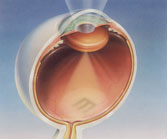
Cataract – As light passes
through the cataractous lens, it is diffused or scattered. The result is blurred or defocused vision.
Simply put, a cataract is a “clouding” of the lens in your eye. The lens, located just behind the iris, or the colored part of your eye, works like the lens in a camera. It picks up images, then focuses the lights, colors, and shapes on the retina —-the transmitter located at the back of your eye that sends the image to your brain.

A small incision, barely noticeable, is made for phacoemulsitication.
The human lens, made mostly of protein and water, can become clouded — so clouded it keeps light and images from reaching the retina. Eye injury, certain diseases, or even some medications can cause the clouding. But, in over 90% of cases, clouding is caused by the aging process.
A cataract can be the reason sharp images become blurred, and seeing things at night is more difficult. It’s why the eyeglasses or contact lenses that used to help you read, or do other simple tasks, no longer seem to help.
A cataract is not a “film” over the eye, and neither diet nor lasers will make it go away. The best way to treat a cataract is to remove the old, clouded lens, and provide a replacement.
Cataract Surgery
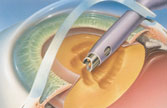
Instrument breaking up and removing pieces of clouded lens.
Great advances have been made in cataract surgery. Millions of people undergo this vision-improving procedure every year. And, they experience excellent results.
For patients, it’s a simple operation. A tiny incision is made in the eye. Through this incision, the surgeon inserts an instrument, about the size of a pen tip. The surgeon may select to use either an AQUALASE® device, which uses gentle pulses of liquid to wash away your cloudy lens, or and ultrasonic instrument that breaks up and gently removes your cloudy lens.
Once the clouded lens has been removed, the next step is to replace it. That is, to implant an artificial lens that will do the work of your own lens. This artificial lens is referred to as an intraocular lens or IOL.
How will it feel?
Cataract surgery is an outpatient procedure. You’ll spend just a few hours at the site. Because your eyes will be numbed with anesthesia, you should feel little to no discomfort.
After the surgery, you’ll be given a short time to rest. Then, the very same day, you can go home. Within the next 24 hours, your doctor will probably want to see you for evaluation. Drops will be prescribed to guard against infection and help your eyes heal. For a few days, you may need to wear a clear shield, especially at night, to prevent you from rubbing your eye.
The Benefits of Cataract Surgery Have Been Enhanced To Also Provide A Natural Filter Against Blue Light.
Your Eyes & Blue Light
Blue light begins the visible range of the light spectrum. While some blue light waves contribute to color perception, other wavelengths of blue light may actually be harmful to your eye.
There are many sources of blue light in your everyday environment including sunlight and artificial lighting.
Researchers believe that blue light may cause damage to the retina which could potentially contribute to macular degeneration or loss of vision. The long-term effects of filtering blue light and the clinical efficacy of that filtering on the retina have not been conclusively established.
The reason you may not have heard about blue light until now is because it has not been well publicized. Recent advances in artificial lens material have just now enabled this concern to be addressed for cataract patients.
The ACRYSOF® Natural IOL Filters Blue Light Like Your Natural Lens

A – Arms ( haptics)
B – Lens body (optic)
The ACRYSOF® Natural IOL lens is a single-piece lens. The arms (or haptics) that keep the lens centered and secure are made of the same soft acrylic material as the lens body.
There have been great advances in artificial lens technology. The ACRYSOF® Natural IOL is an example.
All currently available artificial lenses filter UV light, but the ACRYSOF® Natural IOL filters both UV and blue light. The ACRYSOF® Natural lens is transparent yellow — the color necessary to filter blue light. The patented yellow tint does not alter the natural colors of the things you see or the quality of your vision.
Today, the ACRYSOF® family of lenses, including the ACRYSOF® Natural IOL, are among the most frequently implanted lenses in the world. This is largely due to the long term clinical results of the lens. Furthermore, these lenses are made of a patented material developed specifically for the eye.
This is the only lens crafted entirely from ACRYSOF® acrylic — a soft, flexible material that was developed specifically for use as and IOL. This material behaves well in the eye, contributing to excellent long-term results.
Also, the ACRYSOF® single-Piece IOL is designed to conform to the natural shape of the lens capsule. That helps to stay stable and centered in the eye.
The ACRYSOF® Natural IOL is designed to conform to the natural shape of the lens capsule. This helps it stay stable and centered in the eye. But what makes the ACRYSOF® Natural IOL unique is its ability to filter blue light.
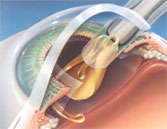
Inserting folded ACRYSOF® lens
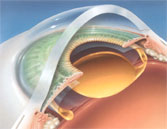
Unfolded ACRYSOF® lens in eye
The ACRYSOF® Natural IOL
The ACRYSOF® Natural IOL enhances the benefits of advanced cataract surgery by filtering out blue light.
The Miracle of Cataract Surgery
When your cataract has been removed it may seem like a miracle. All the things you couldn’t see clearly are bright, clear, and vivid again. In fact, many people will tell you they haven’t seen life so clearly in years.
Once you see how good the world looks, you’ll discover — like millions of others just like you — that a cataract is one thing you can live without.
As with any surgical procedure, there are risks. You and your doctor should consider the potential risks and benefits, and determine if cataract surgery is right for you.
Should you have any questions about cataract surgery, and the new the ACRYSOF® Natural IOL please contact one of the Doctors at Lange Eye Care and Associates by e-mail or by phone.
 Alcon is a Registered Trademarks of Alcon, Inc
Alcon is a Registered Trademarks of Alcon, Inc
 Acrysof® is a Registered Trademarks of Alcon, Inc
Acrysof® is a Registered Trademarks of Alcon, Inc










 Without Glasses?!! that is worth everything to me!
Without Glasses?!! that is worth everything to me!  Cataract surgery has undergone tremendous technological advances since the days of your parents and grandparents. This year, millions of patients will choose to have both their vision and their lifestyles restored, thanks to this life-changing medical procedure.
Cataract surgery has undergone tremendous technological advances since the days of your parents and grandparents. This year, millions of patients will choose to have both their vision and their lifestyles restored, thanks to this life-changing medical procedure.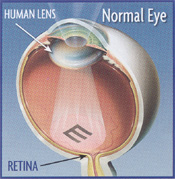 A cataract is a clouding of the natural lens inside your eye. This lens, located behind the iris (or colored part of the eye) works just like the lens of a camera – focusing light images on the retina, which sends the images to your brain.
A cataract is a clouding of the natural lens inside your eye. This lens, located behind the iris (or colored part of the eye) works just like the lens of a camera – focusing light images on the retina, which sends the images to your brain.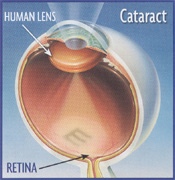 A cataract can be the reason sharp images become blurred, bright colors become dull, or seeing at night is more difficult. It may also be why the reading glasses or bifocals that used to help you read, or do other simple tasks, no longer seem to help. Unfortunately, cataracts can’t be prevented, but removing the cataract and replacing it with and artificial lens can restore your vision and in many ways, significantly improve your quality of life. The time to have your cataracts removed is when the quality of your vision begins to put limits on your activities and enjoyment of life.
A cataract can be the reason sharp images become blurred, bright colors become dull, or seeing at night is more difficult. It may also be why the reading glasses or bifocals that used to help you read, or do other simple tasks, no longer seem to help. Unfortunately, cataracts can’t be prevented, but removing the cataract and replacing it with and artificial lens can restore your vision and in many ways, significantly improve your quality of life. The time to have your cataracts removed is when the quality of your vision begins to put limits on your activities and enjoyment of life. 

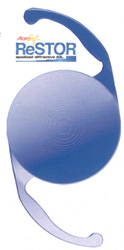 As with any surgical procedure there are inherent risks, and your results cannot be guaranteed. Your doctor will provide you with more detailed information about potential risks and benefits to help decide whether cataract surgery and the AcrySof® ReSTOR® IOL is right for you.
As with any surgical procedure there are inherent risks, and your results cannot be guaranteed. Your doctor will provide you with more detailed information about potential risks and benefits to help decide whether cataract surgery and the AcrySof® ReSTOR® IOL is right for you.